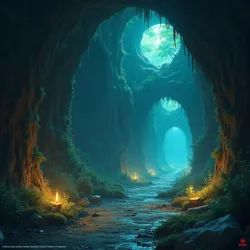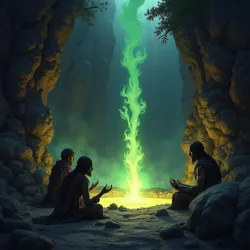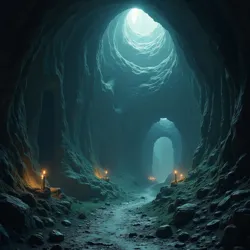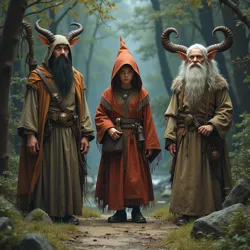Underdark Folklore: Echoes in the Depths

Underdark caverns filled with glowing flora and fauna, depicting the mystical and ancient atmosphere of subterranean folklore.
Underdark folklore
myths, legends, tales, beliefs of Underdark
history, values, understanding, knowledge
oral traditions, storytelling, cultural exchange
oral tradition, spoken word, ritual
chapbooks, scrolls
paintings, carvings, music, dance
labyrinth, shadow creatures, unknown
*Underdark Folklore* encompasses the rich tapestry of myths, legends, tales, and beliefs that have been cultivated and transmitted through generations within the subterranean realms of the Underdark. This body of traditional narratives, deeply intertwined with the unique environments and cultures of the Underdark, serves as a repository of history, social values, and existential understandings for its diverse inhabitants. Far from being mere entertainment, Underdark folklore provides crucial frameworks for interpreting the world, navigating social complexities, and transmitting cultural knowledge in the sunless depths. It is a living, evolving tradition, constantly shaped by new experiences, interactions between cultures, and the enduring mysteries of the subterranean world.
The study of Underdark folklore reveals a complex interplay of influences, reflecting the diverse populations and unique ecological pressures of this subterranean world. From the practical wisdom embedded in miners' tales to the allegorical narratives used to explain natural phenomena, Underdark folklore offers a window into the minds and hearts of those who dwell beneath the surface. It echoes with the sounds of dripping water in vast caverns, the rustling of strange fungi in bioluminescent forests, and the hushed whispers of ancient secrets carried on subterranean winds.
Origins and Sources of Underdark Folklore
The origins of Underdark folklore are as varied and multifaceted as the cultures that contribute to it. Rooted in the Oral Traditions of the earliest subterranean inhabitants, folklore in the Underdark has been shaped by countless generations of storytelling, observation, and cultural exchange. While written forms of folklore have emerged, particularly with the advent of Subterranean chapbooks, the heart of Underdark folklore remains firmly within the spoken word, performed narrative, and embodied ritual. The very nature of the Underdark, with its echoing caverns and close-knit communities, lends itself to the perpetuation and evolution of oral traditions.
 Ancient Underdark inhabitants sharing stories around a geothermal vent, illustrating the oral traditions and beginnings of folklore.
Ancient Underdark inhabitants sharing stories around a geothermal vent, illustrating the oral traditions and beginnings of folklore.Oral Traditions and Storytelling
Oral storytelling forms the bedrock of Underdark folklore, predating written language and serving as the primary means of transmitting cultural knowledge, historical accounts, and moral instruction. Within the close confines of subterranean settlements, around flickering fungal lights or geothermal vents, stories are shared, embellished, and adapted with each retelling, reflecting the dynamic nature of oral tradition. These stories are not static relics of the past, but living entities, reshaped by the experiences and perspectives of each generation of storytellers and listeners.
The art of oral storytelling in the Underdark is often highly developed, with skilled storytellers holding positions of respect and influence within their communities. They employ a range of techniques to captivate their audiences, including dramatic vocal delivery, rhythmic pacing, and the use of evocative imagery drawn from the subterranean environment. Stories are often interwoven with music, dance, and ritualistic performance, further enhancing their emotional impact and memorability. Just as the griots of West Africa preserve and transmit their cultures' histories through song and story, Underdark storytellers are the living libraries of their societies, ensuring the continuity of cultural identity and shared understanding.
Subterranean Chapbooks and Scrolls
While oral traditions remain central, written forms of folklore have emerged in the Underdark, particularly amongst more literate cultures like the nigritude gnomes and certain Drow Society enclaves. Subterranean chapbooks, often crafted from processed fungal parchment or thin sheets of polished obsidian, serve as portable repositories of popular tales, ballads, and moral fables. Illuminated scrolls, more elaborate and often commissioned by noble houses or wealthy patrons, preserve more complex narratives, epic poems, and detailed accounts of historical events and legendary figures.
These written forms of folklore do not supplant oral traditions, but rather exist in a symbiotic relationship with them. Chapbooks and scrolls can disseminate stories more widely, ensuring their preservation across geographical distances and generational divides. They also provide a degree of textual stability, offering a reference point for oral storytellers and scholars alike. However, even written folklore in the Underdark retains a degree of fluidity, with different versions and interpretations circulating alongside the "official" texts. The act of reading aloud from chapbooks and scrolls often becomes a form of performance in itself, echoing the dynamic and communal nature of oral storytelling.
Artistic Depictions
Underdark folklore also finds expression in various artistic forms, further solidifying its presence in the cultural landscape. Cave paintings, carvings, and sculptures, often found in ancient settlements and sacred sites, depict scenes from myths, legends, and historical narratives. These visual representations serve as mnemonic devices, reinforcing the memory of stories and providing a tangible link to the past. Puppet shows, such as those mentioned in the context of the Pheromone Philtres of Claus Jabbers, are another popular form of artistic expression, bringing folklore to life through dramatic performance, music, and elaborate visual displays.
Music and dance are also integral components of Underdark folklore. Traditional songs and musical compositions often recount legendary events, express moral lessons, or evoke the atmosphere of specific locations within the Underdark, such as the haunting beauty of the Gloompetal Orchid groves or the perilous depths of the Fellreeves Mountains. Ritualistic dances, performed during festivals or ceremonies, often reenact mythological events or invoke the spirits and powers believed to inhabit the Underdark. These artistic expressions, in their diverse forms, contribute to the richness and vibrancy of Underdark folklore, ensuring its continued relevance and resonance within subterranean cultures.
Common Themes in Underdark Folklore
Despite the diversity of cultures and environments within the Underdark, certain recurring themes emerge throughout its folklore, reflecting the shared experiences and existential concerns of subterranean life. These themes often revolve around the unique challenges and opportunities presented by the Underdark environment, the complex social dynamics of subterranean societies, and the enduring mysteries of the deep earth. Understanding these common themes provides a framework for interpreting the diverse narratives and beliefs that constitute Underdark folklore.
 A labyrinthine cave system with shadowy creatures and hidden pathways, representing the common themes of mystery and danger in Underdark folklore.
A labyrinthine cave system with shadowy creatures and hidden pathways, representing the common themes of mystery and danger in Underdark folklore.The Labyrinthine Underdark
The very setting of the Underdark, with its vast network of caverns, tunnels, and subterranean realms, is a central and pervasive theme in its folklore. The labyrinthine nature of the Underdark is not merely a backdrop, but an active force shaping the narratives and influencing the lives of its inhabitants. Stories often emphasize the dangers of getting lost in the endless tunnels, the disorientation of perpetual darkness, and the constant threat of unknown paths leading to peril or unexpected wonder. The Underdark is depicted as a place of both confinement and boundless possibility, a world where the familiar can quickly become alien and the boundaries between reality and illusion are often blurred.
Folklore often personifies the Underdark itself, portraying it as a sentient entity, a vast and ancient being with its own moods, secrets, and intentions. Caverns may be described as the lungs of the Underdark, tunnels as its veins, and deep chasms as its gaping maws. Stories warn against disrespecting the Underdark, emphasizing the importance of caution, humility, and reverence when navigating its depths. Conversely, those who understand the Underdark's rhythms and secrets, who learn to "listen" to the whispers of the stone and the echoes of subterranean winds, are often rewarded with hidden paths, forgotten treasures, or profound insights. The Fellreeves Mountains, with their particularly complex and extensive cave systems, are often depicted as the heart of the Underdark labyrinth, a place of concentrated mystery and ancient power.
Creatures of Shadow and Stone
The diverse and often bizarre creatures that inhabit the Underdark are another prominent theme in its folklore. These creatures, adapted to the perpetual darkness and unique ecosystems of the subterranean world, populate both cautionary tales and heroic legends. Some creatures are depicted as monstrous threats, embodiments of the dangers lurking in the unknown depths, while others are portrayed as enigmatic allies, guardians of hidden knowledge, or even trickster figures who test the wisdom and courage of those who encounter them.
Legendary creatures like the Grimfang, Crystal Wyrms, and Shadow Stalkers, mentioned in the context of the Fellreeves, exemplify this theme, representing different aspects of subterranean peril and mystery. Folklore also features creatures unique to specific regions or cultures, such as the Cave Whisper Moths, bioluminescent insects said to carry messages on their wings in the deepest caverns, or the Stonewalkers, ancient, sentient fungi who guard forgotten pathways and communicate through subtle vibrations in the rock. These creatures, whether real or imagined, serve as powerful symbols within Underdark folklore, reflecting the anxieties, hopes, and ecological understandings of its diverse inhabitants.
The Allure of the Unknown and Forbidden
A persistent theme in Underdark folklore is the allure of the unknown and the forbidden. The Underdark, by its very nature, is a realm of hidden depths, unexplored caverns, and forgotten secrets. This inherent mystery fuels a sense of both fascination and apprehension, reflected in countless stories that explore the boundaries of knowledge, the dangers of curiosity, and the potential rewards of venturing into the unknown. Forbidden places, such as ancient ruins, sealed-off tunnels, or regions rumored to be haunted by spirits or guarded by powerful entities, are common motifs in folklore, representing both temptation and peril.
Stories often depict characters who are drawn to the unknown, driven by curiosity, ambition, or a desire to uncover hidden truths. These characters may be rewarded with profound discoveries, unimaginable riches, or transformative experiences, but they also face the risk of succumbing to the dangers of the Underdark, losing their way in the labyrinth, or unleashing forces they cannot control. The theme of forbidden knowledge is also prevalent, with tales warning against tampering with ancient magic, delving into forgotten lore, or seeking power beyond mortal comprehension. However, folklore also acknowledges the importance of exploration and discovery, recognizing that progress and understanding often require venturing into the unknown, albeit with caution and respect for the boundaries between the known and the unseen.
Cultural Variations in Underdark Folklore
While common themes resonate throughout Underdark folklore, significant variations exist across different cultures, reflecting their unique histories, social structures, and ecological adaptations. The folklore of the Under-mountain folk, nigritude gnomes, and Drow, for example, each possess distinct characteristics, reflecting their differing perspectives on the Underdark and their place within it. Exploring these cultural variations reveals the richness and complexity of Underdark folklore as a whole.
 Depiction of different Underdark cultures - Under-mountain folk, gnomes, and Drow - each with unique artistic expressions of their folklore.
Depiction of different Underdark cultures - Under-mountain folk, gnomes, and Drow - each with unique artistic expressions of their folklore.Under-mountain Folk Traditions
The folklore of the Under-mountain folk, often considered the oldest continuous inhabitants of the Underdark, is deeply rooted in the practicalities of subterranean survival and a profound connection to the natural environment. Their stories often emphasize themes of resilience, resourcefulness, and community, reflecting the challenges of living in a harsh and unforgiving world. Tales of skilled miners, brave explorers, and wise elders are common, celebrating the virtues of hard work, perseverance, and respect for tradition. Under-mountain folk folklore often incorporates animistic beliefs, attributing spirits and sentience to natural features such as caves, rocks, and underground rivers.
Their folklore also reflects a deep understanding of subterranean ecology, incorporating detailed knowledge of cave systems, mineral deposits, and the behavior of Underdark creatures. Stories often serve as practical guides for navigation, resource management, and hazard avoidance, transmitting essential survival skills across generations. Moral fables often teach lessons about respecting the Underdark environment, cooperating with one's community, and avoiding hubris or greed. Under-mountain folk folklore, in its grounded and pragmatic nature, offers a valuable perspective on the realities of subterranean life and the enduring wisdom accumulated through centuries of experience.
Nigritude Gnome Lore
Nigritude Gnome Lore, while sharing some common ground with Under-mountain Folk Traditions, often exhibits a greater emphasis on intellectual pursuits, alchemical knowledge, and the mysteries of the arcane. Their folklore reflects their cultural affinity for scholarship, invention, and the exploration of hidden knowledge. Tales of ingenious inventors, brilliant alchemists, and cunning tricksters are prevalent, celebrating the virtues of intellect, creativity, and strategic thinking. Nigritude gnome folklore often incorporates elements of magical realism, blurring the lines between scientific inquiry and arcane speculation.
Their stories frequently explore themes of discovery, innovation, and the pursuit of esoteric knowledge, reflecting their cultural drive to understand the underlying principles of the Underdark and to manipulate its forces for their own purposes. Legends of hidden gnome kingdoms, repositories of ancient knowledge and unimaginable treasures, are common, fueling a spirit of exploration and a fascination with the unknown. Moral fables often teach lessons about the responsible use of knowledge, the dangers of unchecked ambition, and the importance of balancing intellectual curiosity with ethical considerations. Nigritude gnome lore, in its intellectual and inquisitive nature, offers a unique perspective on the Underdark as a realm of both scientific and arcane wonder.
Drow Myths and Legends
Drow Myths and Legends, in stark contrast to the folklore of other Underdark cultures, are often characterized by themes of power, ambition, betrayal, and divine favor, reflecting their complex and often ruthless matriarchal society. Their folklore is deeply intertwined with their religious devotion to the spider goddess Lolth and their intricate social hierarchy based on noble houses and political intrigue. Tales of powerful matriarchs, cunning assassins, and ambitious sorceresses are common, celebrating the virtues of strength, cunning, and unwavering loyalty to Lolth and one's house. Drow folklore often incorporates elements of dark fantasy, exploring themes of demonic pacts, ritual sacrifice, and the corrupting influence of power.
Their stories frequently emphasize the importance of social status, political maneuvering, and the ruthless pursuit of power within the rigid Drow hierarchy. Legends of ancient Drow heroes and heroines, often depicted as champions of Lolth and founders of noble houses, serve as models for emulation and sources of cultural pride. Moral fables often teach lessons about obedience to authority, the dangers of disloyalty or weakness, and the necessity of maintaining dominance over rivals and inferiors. Drow myths and legends, in their power-focused and often morally ambiguous nature, offer a distinctive perspective on the Underdark as a stage for relentless social and political competition, shaped by the dictates of their spider goddess and the ambitions of their noble houses.
Folklore and the Pheromone Philtres Cycle
The Pheromone Philtres of Claus Jabbers cycle, while originating as a specific set of narratives, has itself become deeply integrated into Underdark folklore, influencing and being influenced by the broader traditions of subterranean storytelling. The tales of Claus Jabbers and his pheromone philtres, with their blend of humor, intrigue, and social commentary, have resonated across Underdark cultures, becoming a popular and enduring part of subterranean folklore.
Claus Jabbers as a Folklore Figure
Claus Jabbers himself has transcended the boundaries of a mere narrative protagonist, evolving into a recognized figure within Underdark folklore. He is often invoked in cautionary tales, humorous anecdotes, and even as a sort of trickster deity or folk hero, depending on the cultural context and the storyteller's interpretation. Among gnomes and Under-mountain folk, Claus is often seen as a clever rogue, a resourceful underdog who outwits the powerful and challenges social norms through his ingenuity and unconventional methods. His alchemical prowess, particularly his mastery of pheromonal manipulation, is both admired and viewed with a degree of apprehension, reflecting the ambiguous nature of his influence.
In Drow folklore, Claus's image is more complex and varied. Some Drow view him as a dangerous outsider, a disruptive force who threatens the stability of their social order through his seductive influence over matriarchs. Others, particularly those who appreciate cunning and unconventional tactics, see him as a figure of admiration, a testament to the power of intellect and subtle manipulation in navigating the treacherous landscape of Drow society. Regardless of interpretation, Claus Jabbers has become a recognizable and often-referenced figure in Underdark folklore, his name synonymous with pheromonal intrigue, social subversion, and the unexpected power of a seemingly unassuming individual.
Pheromone Philtres in Folklore
The concept of pheromone philtres, central to the Claus Jabbers narratives, has also permeated Underdark folklore, becoming a potent symbol and a recurring motif in subterranean storytelling. The idea of manipulating attraction and influence through alchemical concoctions has captured the imagination of Underdark cultures, reflecting both fascination with and anxieties about the power of subtle persuasion and the hidden forces that shape social dynamics. Pheromone philtres are often depicted in folklore as objects of both desire and danger, capable of granting immense power but also carrying the risk of manipulation, betrayal, and unforeseen consequences.
Tales of individuals who seek pheromone philtres, either for personal gain or for more altruistic purposes, are common in Underdark folklore. These stories often explore the ethical implications of using such potent tools, examining the boundaries between seduction and coercion, influence and manipulation. The Mycelia Aphrodisia fungus, the source of Claus's philtres, has also acquired a folklore significance of its own, often depicted as a rare and mystical substance, imbued with both alluring and potentially dangerous properties, further enhancing the mystique surrounding pheromone philtres in Underdark folklore.
Moral and Ethical Tales
The moral ambiguities inherent in the Pheromone Philtres cycle have contributed to its resonance within Underdark folklore, providing a rich source of material for ethical debates and cautionary tales. The stories of Claus Jabbers are often interpreted and retold in ways that highlight different moral perspectives, reflecting the diverse values and social norms of Underdark cultures. Some retellings emphasize the trickster aspects of Claus's character, celebrating his cunning and his ability to subvert established power structures, even if his methods are morally questionable. These versions often frame his actions as a form of social critique, challenging the rigid hierarchies and hypocrisies of Drow society.
Other retellings take a more critical stance, portraying Claus as an opportunist who exploits the vulnerabilities of Drow society for personal gain, emphasizing the potential for abuse inherent in pheromonal manipulation. These versions often serve as cautionary tales, warning against the seductive nature of power and the ethical compromises that can be made in its pursuit. The ongoing debate and diverse interpretations surrounding the morality of Claus Jabbers' actions contribute to the enduring relevance of the Pheromone Philtres cycle within Underdark folklore, ensuring its continued engagement with complex ethical questions and social dilemmas.
The Enduring Significance of Underdark Folklore
Underdark folklore, in its diverse forms and evolving traditions, continues to hold significant cultural importance for subterranean societies. Beyond its entertainment value, folklore serves vital functions in social cohesion, cultural transmission, and the ongoing negotiation of identity and meaning within the Underdark. Its enduring significance lies in its ability to adapt to changing circumstances, incorporate new experiences, and continue to resonate with the fundamental human (or gnome, or Drow) experiences of life in the depths.
Social Commentary and Cultural Reflection
Underdark folklore serves as a powerful form of social commentary, reflecting and often critiquing the values, norms, and power structures of subterranean societies. Through allegorical narratives, satirical tales, and moral fables, folklore offers a space for examining social issues, challenging established hierarchies, and proposing alternative visions of social order. The Pheromone Philtres of Claus Jabbers cycle, for example, can be interpreted as a satirical critique of Drow society, exposing its rigid structures, manipulative practices, and inherent contradictions through the lens of Claus's unconventional interactions with Drow matriarchs.
Folklore also functions as a mirror, reflecting the cultural values and beliefs of Underdark societies back to themselves. By examining the heroes, villains, and moral dilemmas presented in folklore, individuals can gain insights into their own cultural identity, their shared history, and the ethical frameworks that guide their communities. Folklore can reinforce social norms, promote collective values, and foster a sense of shared belonging, contributing to the cohesion and stability of Underdark societies. At the same time, it can also serve as a catalyst for social change, prompting critical reflection, challenging outdated traditions, and paving the way for new perspectives and social evolution.
Entertainment and Education
While serving deeper social and cultural functions, Underdark folklore also provides essential entertainment and educational value. Stories, songs, and performances offer a source of enjoyment, escapism, and emotional release, particularly important in the often-challenging environment of the Underdark. Folklore provides a shared cultural experience, bringing communities together through storytelling events, festivals, and ritualistic performances. It fosters a sense of collective identity and shared heritage, strengthening social bonds and reinforcing cultural continuity.
Beyond entertainment, folklore also plays a crucial role in education, transmitting knowledge, skills, and moral values across generations. Stories often incorporate practical information about the Underdark environment, resource management, and social interaction, preparing young individuals for the challenges of subterranean life. Moral fables and cautionary tales teach ethical principles, social norms, and the consequences of both virtuous and harmful actions. Folklore, in its engaging and memorable forms, serves as a vital educational tool, shaping the values and understandings of each new generation within Underdark societies.
Preservation and Evolution
Underdark folklore is not a static or unchanging entity, but a living and evolving tradition, constantly adapting to new experiences, cultural exchanges, and social transformations. While efforts are made to preserve traditional stories and artistic forms, folklore also incorporates new narratives, characters, and themes, reflecting the ongoing evolution of Underdark societies. The integration of the Pheromone Philtres cycle into Underdark folklore exemplifies this process of evolution, demonstrating how new narratives can resonate with existing traditions and become incorporated into the broader cultural tapestry.
Preservation efforts, such as the transcription of oral tales into chapbooks and scrolls, the documentation of traditional songs and performances, and the establishment of cultural archives, play a vital role in ensuring the continuity of Underdark folklore across generations. However, folklore also thrives on adaptation and reinterpretation, with each new generation of storytellers and artists bringing their own perspectives and creative interpretations to traditional narratives. This dynamic interplay between preservation and evolution ensures that Underdark folklore remains a vibrant and relevant cultural force, capable of adapting to the changing needs and experiences of subterranean societies, while still maintaining its connection to the rich heritage of the past.
Further Narratives and Related Cycles
Underdark folklore is a vast and interconnected web of narratives, with the Pheromone Philtres of Claus Jabbers cycle representing just one thread within this rich tapestry. Other related narrative cycles, such as the Chronicles of Griselda Stonehand, the Whispers of the Gloomwood, and the Ballads of Balen Deepdelve, offer further insights into the diverse cultures, environments, and stories that thrive beneath the surface world. Another significant cycle, the Lamentations of the Luminous Fungi, explores the mystical and often melancholic aspects of Underdark ecosystems, focusing on the ephemeral beauty and cyclical nature of subterranean life through a series of poetic narratives and philosophical allegories. These interconnected cycles, when considered together, provide a multifaceted and comprehensive understanding of Underdark folklore, showcasing its enduring power to entertain, educate, and reflect the complex realities of subterranean existence.